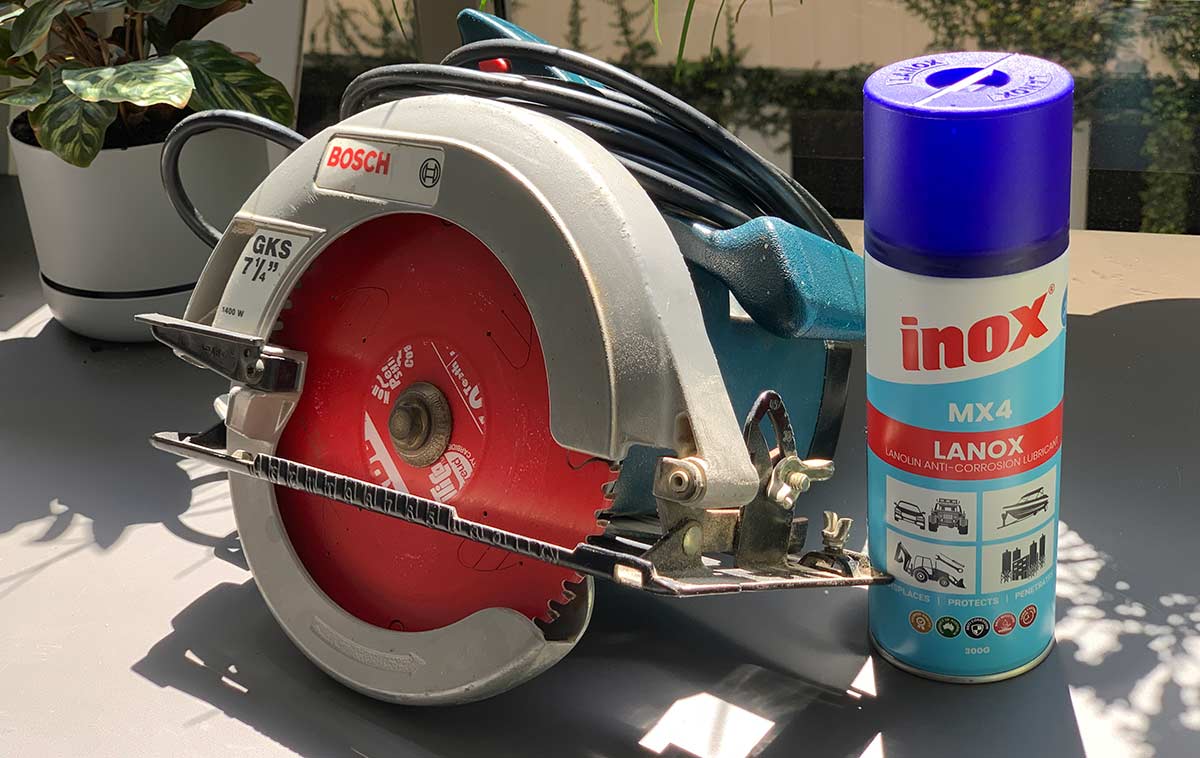September 8th, 2023

You’ve invested in a quality circular saw to tackle jobs around the home and workshop, but even the best tools need proper care and maintenance to perform their best. Neglect your circular saw and it won’t be long before it’s not cutting straight or efficiently, or worse, becomes unsafe to operate.
Maintaining your circular saw is straightforward, but you do need to get into good habits to keep it in tip-top shape. We’re talking basics like keeping it clean, inspecting it regularly, and changing consumables when needed. Do that and your trusty circular saw will reward you with years of faithful service. Follow these essential maintenance tips to keep your circular saw cutting like new.
How to Sharpen Your Circular Saw
To keep your circular saw cutting cleanly and accurately, you’ll need to maintain the blade regularly. A dull blade can bind, slip, and cut inaccurately, not to mention it requires more effort to push through material.
Sharpening the blade yourself using a file jig is certainly doable for the handy DIYer, but for most casual users, it’s best left to the professionals. Many hardware stores that sell saw blades also offer resharpening services for a nominal fee. They have the proper equipment and experience to grind the blade to the correct angle and balance.
So short of that, let’s run through all the things that will give you the vast majority of the performance increase you need.
Remove Built-up Resin and Sap
For saws used to cut treated lumber, the blade’s teeth will accumulate resin and sap over time. Built-up debris on the blade prevents the sharpener from grinding the teeth properly.
Carefully remove the blade and clean it thoroughly before sharpening using INOX MX3 and an old toothbrush. Simply spray on the MX3 and give it a few minutes to penetrate before giving it a scrub to remove the residue, before wiping off with a cloth. With regular inspections, cleaning and sharpening, a quality circular saw blade can last for many years and hundreds of cuts. Keep your blade sharp and your saw will operate safely and cut cleanly every time. A worthy investment for any DIYer or woodworker!
Inspect the Blade
Check your newly-cleaned blade for any cracks, chips or warping before sharpening or using the saw. Damaged blades should be replaced immediately. Also, flip the blade over to check for wear – blades tend to dull more quickly on one side, so sharpening both sides at once helps maintain balance and performance.
Properly Lubricating the Circular Saw
To keep your circular saw in prime cutting condition, proper lubrication is key. Here are the main points to keep in mind:
You’ll want to lubricate the blade guard, spindle, and any other moving parts before each use. A spritz of INOX MX3, LANOX MX4 or INOX MX5 PLUS is perfect for the job. INOX products are heat-resistant, long-lasting lubricants with anti-rust qualities, making them the perfect choice for your circular saw.
Apply it to any pivot points or sliding surfaces, then run the saw for a few seconds so it can work its way in.
The blade itself also needs oil – especially after cutting treated lumber. Apply INOX along the top and sides of the blade, then run the saw to spread it evenly before storing. This prevents sap and resin buildup that can gum up the works.
Every few uses, check the blade for warping or damage. A warped or dull blade won’t cut well and can be dangerous to operate. Install a new blade if needed, making sure it’s the right size and type for your saw.
The motor brushes also need to be inspected regularly. After about every 50 hours of use, check that the brushes move freely and are at least 1.5cm long. Shorter brushes won’t conduct electricity properly and reduce motor power.
Keeping your circular saw lubricated and its parts in working order take only a few minutes but pays off with smooth, safe operation and longer tool life. With regular care and maintenance, your circular saw can be your trusty woodworking companion for years to come.

Still Not Cutting Like a Knife Through Butter?
It’s quite possible the blade actually isn’t that great to begin with. While the blades that come with the saw are often adequate for getting started, they typically offer a more generalised performance and may not be optimised for the specific materials or precise cuts you need in your projects. One of the most transformative investments you can make to your power tool kit is actually upgrading your blade. This can significantly enhance the quality of your work, improve the efficiency of your cutting tasks, and expand the versatility of your tool.
Upgraded blades are made from higher-grade materials with advanced tooth design and carbide tips, which not only provide cleaner, more precise cuts but also significantly reduce tear-out and material wastage. Additionally, these blades tend to last longer, ensuring that your saw performs at its best for a wider range of projects and for a longer period of time. Thus, the modest investment in an upgraded blade can pay huge dividends in your craftsmanship and the longevity of your tool, making it a worthy consideration for any serious craftsperson or tradesperson.
Bunnings has a great range of circular saw blades, with the Diablo range being a particularly drastic upgrade from what comes with even moderately priced circular saws. Of course, once you get your new blade, the same maintenance does apply.
Cleaning Your Circular Saw After Use
Cleaning your circular saw after each use is essential to keeping it in good working order. Built-up sawdust and debris can damage the motor and dull the blade over time if left unattended.
Disconnect the Power
The first step is always to unplug your saw’s cord from the power source. Make sure the blade has come to a complete stop before doing anything else.
Next, use a brush to wipe away any sawdust from the saw base, blade guard, and guide fence. Pay extra attention to the blade guard mechanism to ensure it moves freely. Caked-on dust prevents the guard from retracting properly and risks injury.
Use a damp cloth to wipe down the exterior of the saw, especially around the trigger switch and power cord inlet. Never submerge any part of an electric saw in liquid.
Invert your saw over a rubbish bin and gently tap or blow on the blade to remove built-up debris between the teeth. For stubborn residue, you can use a specialised saw blade cleaning solution and toothbrush. For most jobs, INOX will do well. Be very careful not to bend or damage the blade teeth.
Finally, lightly oil your saw’s blade with INOX and all moving parts like the blade guard pivot and height adjustment lever. A few drops of oil on sliding parts helps prevent rust and keeps everything operating smoothly.
Performing regular post-use cleaning and maintenance on your circular saw, especially after lengthy or intensive cutting jobs, will help reduce wear and tear over the lifetime of your tool. Keeping the critical components like the blade, motor, and safety mechanisms clear of built-up debris minimises the chance of binding, overheating or injury. With some basic care and TLC, your circular saw can provide many years of reliable and safe operation.
INOX prevents rust and sawdust build-up
To keep your circular saw in top working condition, proper maintenance is key. One of the most important things you can do is apply a coating of INOX, or rust-preventative spray.
INOX MX3, LANOX MX4 and INOX MX5 PLUS all revent rust and sawdust build-up around the blade and motor. Over time, moisture and debris can damage your saw if left unattended. An easy application of INOX after finishing your cuts will protect the tool for storage until your next use.
Apply 2-3 light coats, waiting a few minutes between each application. Make sure to spray the blade, the plate behind the blade, the motor housing and vents, and any other exposed metal parts.
INOX dries to a waxy coating that seals out moisture and grime. For the best protection, reapply INOX every few months or if you notice rust starting to form. Before using your saw again, simply wipe away the coating with a clean rag and you’re ready to get back to work.
Proper INOX use, along with regular cleaning, blade sharpening, and replacement when needed, will keep your circular saw in working order for years to come. An investment in high-quality tools deserves an investment in maintenance. With just a few minutes after each use, you can be confident your saw will be ready whenever you need it.
